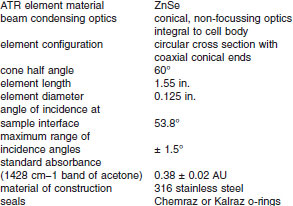ASTM D6277 Standard Test Method for Determination of Benzene in Spark-Ignition Engine Fuels Using Mid Infrared Spectroscopy
7. Apparatus
7.1 Mid-IR Spectrometric Analyzer (of one of the following types):
7.1.1 Filter-based Mid-IR Test Apparatus - The type of apparatus suitable for use in this test method minimally employes an IR source, an infrared transmission cell or a liquid attenuated total internal reflection cell, wavelength discriminating filters, a chopper wheel, a detector, an A-D converter, a microprocessor, and a method to introduce the sample. The frequencies and bandwidths of the filters are specified in Table 1.
7.1.2 Fourier Transform Mid-IR Spectrometer - The type of apparatus suitable for use in this test method employs an IR source, an infrared transmission cell or a liquid attenuated total internal reflection cell, a scanning interferometer, a detector, an A-D converter, a microprocessor, and a method to introduce the sample. The following performance specifications (through the ATR cell) must be met:

The signal to noise level will be established by taking a single beam spectrum using air or nitrogen as the reference and declaring that spectrum as the background. The background single beam spectrum obtained can be the average of multiple FTIR scans, but the total collection time shall not exceed 60 s. If interference from water vapor or carbon dioxide is a problem, the instrument shall be purged with dry air or nitrogen. A subsequent single beam spectrum shall be taken under the same conditions and ratioed to the background spectrum. The RMS noise of the ratioed spectra, the 100 % line, shall not exceed 0.3 % transmittance in the region from 700 to 664 cm(-1).
7.2 Absorption Cell - The absorption cell can be either transmission or attenuated total reflectance.
7.2.1 Transmission Cells, shall have windows of potassium bromide, zinc selenide, or other material having a significant transmission from 712 cm(-1) to 660 cm(-1). The cell path length of the transmission cell shall be 0.025 (±0.005) mm. The use of a wedged transmission cell with the same nominal path length is acceptable.
7.2.2 Attenuated Total Reflectance (ATR) Cells, shall have the following specifications:

8. Reagents and Materials (see Note 1)
8.1 Standards for Calibration, Qualification, and Quality Control Check Standards - Use of chemicals of at least 99 % purity, where available, for quality control checks is required when preparing samples. (Warning - These materials are flammable and may be harmful if ingested or inhaled.)
8.1.1 tert-Amyl methyl ether, TAME [994-05-8].
8.1.2 Benzene [1076-43-3].
8.1.3 tert-Butyl ethyl ether, ETBE [637-92-3].
8.1.4 tert-Butyl methyl ether, MTBE [1634-04-4].
8.1.5 1,3 Dimethylbenzene (m-xylene).
8.1.6 Ethanol [64-17-5].
8.1.7 Ethylbenzene [100-41-4].
8.1.8 3–Ethyltoluene [620-14-4].
8.1.9 Heavy aromatic/reformate petroleum stream (high boiling cut: IPB of 150 ± 5° C and EP of 245 ± 8° C) certified to contain less than 0.025 % benzene (an absorbance of less than 0.03 at 675 cm(-1) using a 0.2 mm cell and a baseline between approximately 680 cm(-1) and 670 cm(-1) [64741-68-0].
8.1.10 Hexane (an absorbance versus water of less than 0.1 at 250 nm using a 1 cm cell) [110-54-3].
8.1.11 2,2,4-Trimethylpentane (isooctane) [540-84-1].
8.1.12 Pentane (an absorbance versus water of less than 0.1 at 250 nm using a 1 cm cell) [109-66-0].
8.1.13 Propylbenzene [103-65-1].
8.1.14 Toluene [108-88-3].
8.1.15 1,3,5-Trimethylbenzene (mesitylene) [108-67-8].
8.1.16 m-Xylene [108-38-3].
NOTE 1 - Only some of the reagents are required in each calibration or qualification procedure.
9. Sampling and Sample Handling
9.1 General Requirements:
9.1.1 The sensitivity of the measurement of benzene to the loss of benzene or other components through evaporation and the resulting changes in composition is such that the utmost precaution and the most meticulous care in the drawing and handling of samples is required.
9.1.2 Fuel samples to be analyzed by the test method shall be sampled using procedures outlined in Practices D4057, D4177, or D5842, where appropriate. Do not use the "Sampling by Water Displacement". With some alcohol containing samples, the alcohol will dissolve in the water phase.
9.1.3 Protect samples from excessive temperatures prior to testing. This can be accomplished by storage in an appropriate ice bath or refrigerator at 0 to 5°C.
9.1.4 Do not test samples stored in leaky containers. Discard and obtain a new sample if leaks are detected.
9.2 Sample Handling During Analysis:
9.2.1 When analyzing samples by the mid infrared apparatus, the sample must be between a temperature of 15 to 38° C. Equilibrate all samples to the temperature of the laboratory (15 to 38°C) prior to analysis by this test method.
9.2.2 After analysis, if the sample is to be saved, reseal the container and store the sample in an ice bath or a refrigerator at 0 to 5°C.



